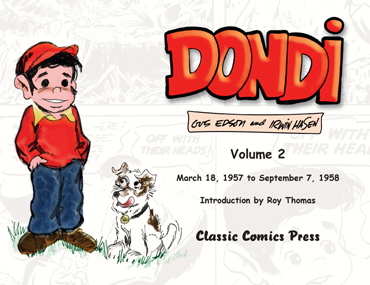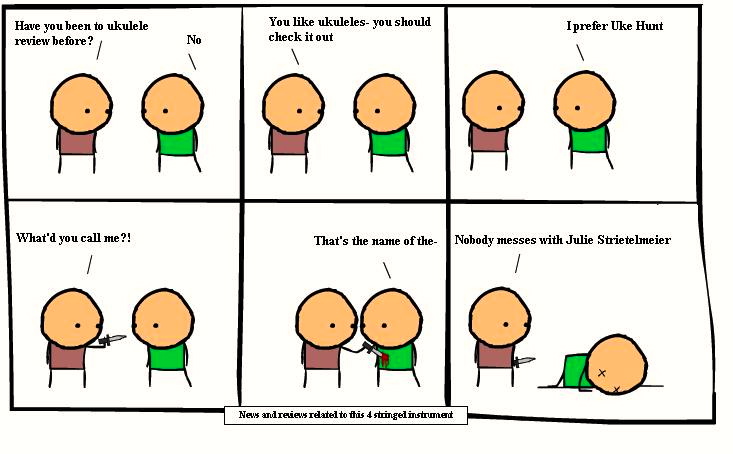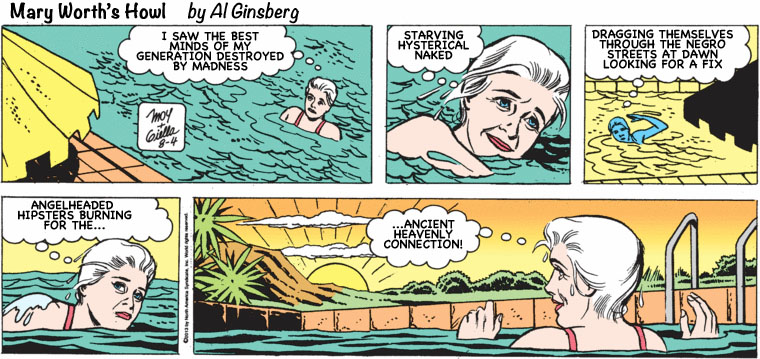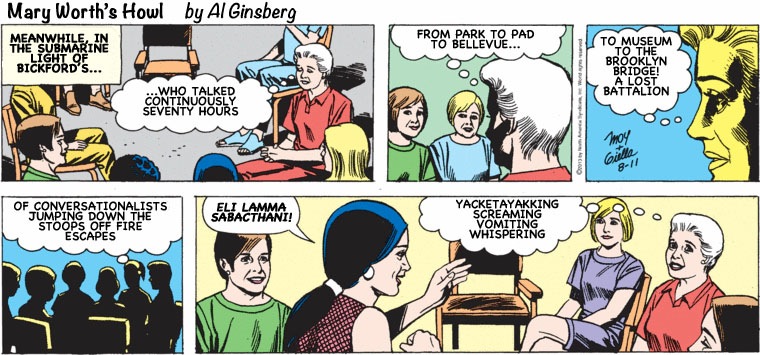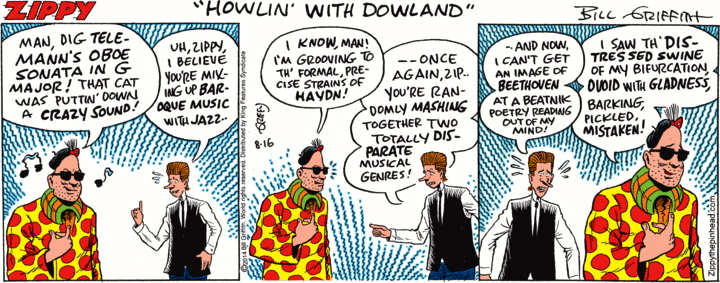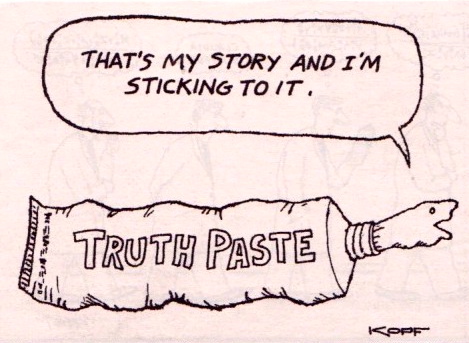Poerody
Ziegler on toast
Two cartoons about toast from The Essential Jack Ziegler (ed. by Lee Lorenz, 2000): the Bureau of Missing Toast and The Scream in toast:
Toast is so ordinary, so everyday, so uncomplicated, that making anything of it is likely to be at least a bit funny.
But Ziegler’s first cartoon above treats toast as precious and beloved, so that a missing slice of toast is as distressing as a missing family member or missing pet. Similarly, Bob and Ray’s wonderful House of Toast ad treats toast as so special it deserves shops devoted to supplying it, in all of its many varieties
Then there’s Ziegler’s somewhat surrealistic toast version of Edvard Munch’s The Scream — one in a long series of parodies of the painting (some here; more here, with information on the painting).
Topical bonus: a Matt Wuerker POLITICO cartoon with Munch-style screams at the advance of “socialism” (leaving out public fire companies, public libraries, and more):
Finally, for information on Ziegler, see this posting with his cartoon on spelling rage.

Ducks
Back from Stanford Hospital since Saturday morning. Things move very slowly on weekends. so nothing much has happened. I sleep most of the day, attended by Ned and Elizabeth. Not yet able to move around much, nor have I mastered the intricacies of the walker, which are considerable, and the effects of the pain medication (lots of oxy), which are complex, sometimes overwhelming.
But on more pleasant fronts, there’s the PBS Nature show I saw on tv (on Friday? my time perceptions are unsteady indeed), about ducks. A “duckumentary”; I suppose that was inevitable. Full of wonderful shots of ducks of many kinds — alone, in families, in flocks.
We were taught that every species of duck is either a dabbler duck or a diver duck. Or, as Gilbert & Sullivan would have it:
Every duck and every drake
Is either a little dabbler
Or else a little diver.
Hey, I’m coming back to life very very gradually.

Tiptoe
Today’s Zippy has our hero producing yet another burlesque of popular music (for a survey of burlesques, parodies, and playful allusions on this blog, look here):
The song is “Tiptoe Through the Tulips”, made famous by the Tiny Tim performance of it on the ukelele (hence Griffiths’s title “Tiny Whim”) in the 1960s.
But the tune goes back to 1929, when it was featured in one of the very earliest talkies, Gold Diggers of Broadway — where Nick Lucas performed the song “Tip-Toe Through the Tulips” in a romantic tenor:
(a *fabulous* clip). The words to the Al Dubin/Joe Burke song:
Tiptoe through the window
By the window, that is where I’ll be
Come tiptoe through the tulips with meOh, tiptoe from the garden
By the garden of the willow tree
And tiptoe through the tulips with meKnee deep in flowers we’ll stray
We’ll keep the showers away
And if I kiss you in the garden, in the moonlight
Will you pardon me?
And tiptoe through the tulips with me
Now zip forward about 40 years to Tiny Tim, appearing on television on Rowan and Martin’s Laugh-In. Here he is in his first appearance (of many), where he was presented as a figure of fun (with jokes about his sexuality):
A note on the man:
Tiny Tim (born Herbert Khaury; April 12, 1932 – November 30, 1996) was an American singer, ukulele player, and musical archivist. He was most famous for his rendition of “Tiptoe Through the Tulips” sung in a distinctive high falsetto/vibrato voice. (Wikipedia link)
(His presentation of self was always as a gentle asexual person, playful and sweet. His memorial site here.) Finally, a 1968 performance of his signature tune:
Meanwhile, Zippy tiptoes through the trousseau. Oboes, chimpanzees, tenpins, tweed, and a wheelwright are involved.

Being someone else
Claude and Griffy muse over identity and soft serve in today’s Zippy:
According to my records, Zippy and soft serve came together last in December, when I wrote, here:
In ZippyPopLand, redemption can be found in soft serve. (In particular, New England Soft Serve … in Colchester CT)
The Wikipedia entry on soft serve begins by treating the stuff as a kind of ice cream, which is the way ordinary people think of it:
Soft serve is a type of ice cream that is softer than regular ice cream. Soft serve ice cream has been sold commercially since the late 1930s.
… in ordinary English, ice cream covers a variety of frozen confections — but in the United States, the label is regulated, so that, technically, soft serve is not ice cream.
The inventor of the stuff is disputed; Carvel (Tom Carvel, in Hartsdale NY) and Dairy Queen (J.F. McCullough and his son Alex, near Moline IL) have competing claims to the invention of soft serve. It happened in the 1930s, in any case.
Nice contrast between soft serve and hard-nose (as applied to Dick Cheney).
The cast of characters:
Dick Cheney: Richard Bruce “Dick” Cheney (born January 30, 1941) is an American politician and businessman who was the 46th Vice President of the United States from 2001 to 2009, under President George W. Bush. (link)
Captain Queeg: Lieutenant Commander Philip Francis Queeg, USN, is a fictional character in Herman Wouk’s 1951 novel The Caine Mutiny. He is also a character in the identically titled 1954 film adaptation of the novel and in The Caine Mutiny Court Martial, the Broadway theatre adaptation of the novel that opened in the same year as the film. (link)
Dondi: Dondi was a daily comic strip about a large-eyed war orphan of the same name. Created by Gus Edson and Irwin Hasen, it ran in more than 100 newspapers for three decades (September 25, 1955 to June 8, 1986).
… Dondi’s original backstory describes him as a five-year-old World War II orphan of Italian descent. The boy had no memory of his parents or his name, so when a pretty Red Cross worker said he was “a dandy boy,” he thought she was naming him “Dondi.” Two soldiers who spoke no Italian, Ted Wills and Whitey McGowan, found the child wandering through a war-torn village. The soldiers brought the child back to the United States and Ted eventually became his adoptive father. (link)
Little Lulu, from Wikipedia: ”Little Lulu” is the nickname for Lulu Moppett, a comic strip character created in the mid-1930s by Marjorie Henderson Buell. The character debuted in The Saturday Evening Post on February 23, 1935 in a single panel, appearing as a flower girl at a wedding and strewing the aisle with banana peels. Little Lulu replaced Carl Anderson’s Henry, which had been picked up for distribution by King Features Syndicate. The Little Lulu panel continued to run weekly in The Saturday Evening Post until December 30, 1944.
… [main characters] “Little” Lulu Moppet: Lulu is the title character and is often the ringleader of the girls… Lulu is a kind and sincere little girl who, though prone to mischief, usually ends up saving the day.
Thomas “Tubby” Tompkins: Tubby, whose real name is Thomas, is Lulu’s friend and the leader of the fellers. He has helped Lulu many times and has tormented her just as much.
Irwin Tripp: Irving Rose Tripp (June 5, 1921 – November 27, 2009), was an American comic book artist, best known as the illustrator of Little Lulu comics. (link)
A bonus from the Zippy site: ”Zippy’s Comic Book Collection”:
30 little imaginary Zippy Comic covers, incuding horror, western, romance, funny animal and other titles. Parodies of Little Lulu, Plastic Man, Archie, Captain Marvel and more.
Little Lulu is in the bottom row, the second full panel.

On the Weiner watch
Commenting on Facebook on my Anthony Weiner posting of yesterday, Dennis Lewis alerts me to the gay porn parody flick Anthony’s Weener (Jet Set Men, 2011). I suppose it was inevitable.
The front cover of the DVD, cropped so as to remove Anthony’s wiener; the full X version will appear in a posting on AXBlogX:
Brian Moylan on Gawker, 10/7/11, “Anthony Weiner Gets the Gay Porn Parody He Deserves”:
Jet Set Studios, the gay porn company behind such comedic gems as Getting Levi’s Johnson and To Fuck a Predator, has just released Anthony’s Weener. It’s the story of what happens when a gay Congressman accidentally tweets a picture of his penis. Don’t worry, the trailer above is safe(ish) for work.
It has everything: drama, intrigue, politics, abs, jokes about politicians who turn out to be gay, a sweet message about marriage equality, 10-inch cocks, and the Boehner joke you always wanted to make. What’s not to love? And because I know you people are perverted enough to watch it but too lazy to find it on your own, you can watch the hardcore version here. Just, you know, don’t send around pictures of yourself watching it.
The synopsis of the plot:
Anthony’s Weener is the most anticipated gay adult parody of the year! It stars Lucky Daniels as Congressman Wheiner [Weiner], Angel Rock as right wing blogger Andrew Breitpart [Breitbart], Ricky Sinz as Speaker Bohner [Boehner] and Marc Dylan as Senator David Litter [Vitter]. Co-starring Jacob Durham, Jackson Klein, A.J. Monroe, Cameron Foster and Trevor Knight as former Senator Harry Craig [Larry Craig, of "wide stance" fame], Anthony’s Weener is sure to rock the halls of Capitol Hill.

Lavender and dill
Today’s Zippy has Zerbina strumming her version of death metal on the ukulele:
Where to start? There’s Cannibal Corpse and the song “Evisceration Plague”; the source for Zerbina’s burlesque version; and the ukulele as an instrument. Certainly, death metal on a ukulele is risible.
Ok, Cannibal Corpse is a real band (Bill Griffith wouldn’t make such a thing up, at least not when there are gems like this to be found in real life):
Cannibal Corpse is an American death metal band from Buffalo, New York. Formed in 1988, the band has released twelve studio albums, one box set, and one live album. Throughout the years the band has been established, they have had little radio or television exposure, although a cult following began to build behind the group with the release of albums such as 1991′s Butchered at Birth and 1992′s Tomb of the Mutilated which both reached over one million in worldwide sales by 2003, including 558,929 in the United States by 2003, making them the top-selling death metal band of all time in the US.
… Evisceration Plague, Cannibal Corpse’s eleventh studio album was released February 3, 2009, to a highly positive response from fans.
… In May 1995, then-US Senator Bob Dole accused Cannibal Corpse — along with hip hop acts like the Geto Boys and 2 Live Crew — of undermining the national character of the United States. A year later, the band came under fire again, this time as part of a campaign by conservative activist William Bennett, Senator Joe Lieberman, then-Senator Sam Nunn, and National Congress of Black Women chair C. Delores Tucker to get major record labels — including Time Warner, Sony, Thorn-EMI, PolyGram and Bertelsmann — to “dump 20 recording groups…responsible for the most offensive lyrics.” [In fact, the band and its recordings have been banned in several jurisdictions.]
… Cannibal Corpse prides itself on overtly violent-themed songs and album artwork, which it sees as nothing more than an extreme form of over-the-top entertainment. In the film Metal: A Headbanger’s Journey, George [“Corpsegrinder”] Fisher [of the bands Monstrosity and Cannibal Corpse] said death metal is best viewed “as art”, and claimed that far more violent art can be found at the Vatican, saying that such depictions actually happened. Some of Cannibal Corpse’s most controversial song titles include “Meat Hook Sodomy”, “Entrails Ripped from a Virgin’s Cunt”, “Necropedophile”, and “Fucked with a Knife”. (Wikipedia link)
The lyrics for the song “Evisceration Plague” are nothing like Zerbina’s burlesque version. But they are based on something on the Evisceration Plague album, namely this verse of the song “To Decompose”:
Cadaver filled carcasses flood the land
Methodically emptied of bone and blood
Left to be one with the dirt again
To decompose
It will all end in the dirt again
(Meanwhile, lavender and dill for cadaver filled provides a distant echo of the folk song “Lavender Blue”, with the line “Lavender’s blue, dilly dilly, lavender’s green”. And scone and snood is a nice nonsensicalization of bone and blood.)
Now, the ukulele:
The ukulele …, sometimes abbreviated to uke, is a member of the guitar family of instruments; it generally employs four nylon or gut strings or four courses of strings.
The ukulele originated in the 19th century as a Hawaiian interpretation of the machete, a small guitar-like instrument related to the cavaquinho, braguinha and the rajao, taken to Hawaii by Portuguese immigrants. It gained great popularity elsewhere in the United States during the early 20th century, and from there spread internationally. (Wikipedia link)
Some people think of the uke as a silly plinking instrument, and Bill Griffith has evoked it at least once before, in a strip in which Zippy burlesques “Tiptoe Through the Tulips” on the ukulele.
Bonus: looking up ukulele sites led me to a Ukulele Hunt posting with a cartoon inspired by Cyanide and Happiness:
(Julie Strietelmeier is a gadgeteer and ukulele player.)
For the Uke Hunt joke, compare Mike Hunt and York Hunt in this posting.

Mashup: Mary Worth’s howl
Considering mashups of different artistic genres, Josh Millard offers Mary Worth’s Howl:
Mary Worth’s Howl, by Al “Screwball” Ginsberg [8/15/13]
So, Lauren LoPrete‘s Peanuts + Smiths Lyrics mashup blog, This Charming Life, has been making the rounds; it ended up on Metafilter yesterday, which led to much riffing on other possible comic/band juxtapositions, and I saw someone mention Mary Worth and joked that it should in fact be: Mary Worth and excerpts from Howl.
In seven panels:
On Mary Worth, from Wikipedia:
Mary Worth is a newspaper comic strip, which has had a seven-decade run since it began in 1938 under the title Mary Worth’s Family. Distributed by King Features Syndicate, this pioneering soap opera-style strip had an influence on several realistically drawn continuity strips that followed.
… As scripted by Saunders, each story (and its cast) was independent, with little continuity to the next, and Mary generally made only brief appearances to react and give her matronly advice. A former teacher and widow of Wall Street tycoon (Jack Worth), Mary formerly lived in New York and later moved to the Charterstone Condominium Complex in fictional Santa Royale, California. Mary serves as an observer of and adviser to her fellow residents, tackling issues such as drug and alcohol abuse, infidelity and teen pregnancy. Only in recent decades (after Saunders retired) has the strip centered more on the title character, along with a regular cast of her closest friends, most of whom were introduced to the strip after 1980

Family Circuses
From Mary Ballard on Facebook, a link to the Nietzsche Family Circus site, offering randomized pairings of Family Circus cartoons and Friedrich Nietzsche quotes, like this one:
In every real man a child is hidden that wants to play.
On The Family Circus on this blog, see this piece on word play in the cartoon, with links to earlier postings.
The cartoon is often parodied. Here’s one take-off on the blog. Then there’s the Dysfunctional Family Circus:
The Dysfunctional Family Circus is the name of several long-running parodies of the syndicated comic strip The Family Circus, featuring either Bil Keane’s artwork with altered captions, or (less often) original artwork made to appear like the targeted strips. First distributed anonymously by mail and fax in 1989, by 1994 various versions of it began to appear on the World Wide Web. (Wikipedia link)
One example:
And then there’s Nietzsche.

More Family Circus parodies
On tumblr, the comic Time is a Flat Circus, with recaptioned Family Circus comics — most not deeply linguistic, but rather dark and pointed. Two examples, from 12 and 14 April, respectively:
Earlier parodies in this posting of 2/2/14: Nietzsche Family Circus and Dysfunctional Family Circus. The cuteness of the originals invitex this sort of reworking.

Three for today
Three cartoons for today: a Dilbert, a Bizarro, and a Mother Goose and Grimm:
#1 shows the pointy-headed boss failing to respect the Gricean maxim of Quantity, by saying considerably less than what’s required in the context (“We need it for various things, and so on”); the suggestion is that the boss simply has no idea what’s required in the context, or is unable to supply a clear and informative answer,
#2 shows a combination of two prominent images from popular culture, both very frequently parodied: the couple from Grant Wood’s American Gothic, and Batman, with a pun on Gothic / Gotham, Gotham City being the locale of Batman.
Finally, in #3, another pun (mildly off-color) on plucked ‘with feathers removed’ vs. metaphorical fucked ‘ruined’.

For National Cartoonists Day
This morning I discovered that yesterday was not only Cinco de Mayo, but also National Cartoonists Day. In honor of the occasion, three cartoons for today. Then some account of Cartoonists Day, which leads to the early newspaper cartoon featuring the Yellow Kid.
1. Three cartoons today. Two (a Rhymes With Orange and a Zippy) on means of communication, plus a Zits on what counts as retro to whom.
A parody of Dr. Seuss’s Cat in the Hat, with chat instead of hat.
Old-fashioned communication, on paper (“snail mail”, stressing the slowness) or face-to-face (“oral download”!), vs. trendy means of communication (of five types); the difference is a recurrent theme in Zippy the Pinhead, and also in Zits.
(Odds and ends: as usual, the proper names, which I won’t try to unpack here. Anyone who would like to take a bash at the first two — I assume that Einstein Feinstein is, as Zippy names go, straightforward — is welcome to. The egg is probably just a bit of surrealism. Credenza is there because it’s a delicious word. And we get Judge Judy again.)
2. National Cartoonists Day and the Yellow Kid. The second is the source of the first. See the Wikipedia page (with the crucial bit boldfaced):
The Yellow Kid was the name of a lead comic strip character that ran from 1895 to 1898 in Joseph Pulitzer’s New York World, and later William Randolph Hearst’s New York Journal. Created and drawn by Richard F. Outcault in the comic strip Hogan’s Alley (and later under other names as well), it was one of the first Sunday supplement comic strips in an American newspaper, although its graphical layout had already been thoroughly established in political and other, purely-for-entertainment cartoons.
… Mickey Dugan, better known as The Yellow Kid, was a bald, snaggle-toothed boy who wore an oversized yellow nightshirt and hung around in a slum alley typical of certain areas of squalor that existed in late 19th-century New York City. Hogan’s Alley was filled with equally odd characters, mostly other children. With a goofy grin, the Kid habitually spoke in a ragged, peculiar slang, which was printed on his shirt, a device meant to lampoon advertising billboards.
The character who would later become the Yellow Kid first appeared on the scene in a minor supporting role in cartoon panel published in Truth magazine in 1894 and 1895. The four different black-and-white single panel cartoons were deemed popular, and one of them, Fourth Ward Brownies, was reprinted on 17 February 1895 in Joseph Pulitzer’s New York World, where Outcault worked as a technical drawing artist. The World published another, newer Hogan’s Alley cartoon less than a month later, and this was followed by the strip’s first color printing on 5 May 1895. Hogan’s Alley gradually became a full-page Sunday color cartoon with the Yellow Kid (who was also appearing several times a week) as its lead character.
Two images of the Yellow Kid:
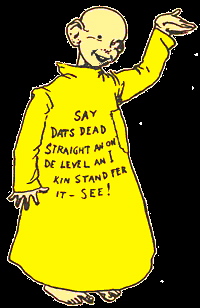 (#3)
(#3)
Hogan’s Alley is from what some have called “the platinum age” of the comics (preceding and surpassing the golden age). Besides the Yellow Kid, characters from this time include Little Nemo, Krazy Kat, and Micky Mouse.

The song sparrow
Today’s revisiting of Calvin and Hobbes:
The song sparrow segues into a bit of kidlore (beloved by campers and scout troops), and that gets Calvin thrown out of the house by his mother.
A lot of kidlore has no traceable history, but this one has an official story.
The Wikipedia account:
“On Top of Spaghetti” is a ballad and children’s song written and originally performed by folk singer Tom Glazer with the Do-Re-Mi Children’s Chorus in 1963. The song is sung to the tune of “On Top of Old Smoky”. It is essentially the tale of a meatball that was lost when “somebody sneezed”. The song discusses what happened to the meatball after it fell off of a pile of spaghetti and rolled away.
An early version of the song, attributed to middle school students in Lodi, California, was printed in the Lodi News-Sentinel on January 25, 1961.
The Glazer version is available on YouTube. I find it annoyingly cutesy and much prefer a 1999 version by the Persuasions, on their kids’ album Good Ship Lollipop (a version that is unfortunately not available on-line, so far as I can tell).
I was a bit surprised to discover that the song is only about 50 years old, but then estimates of time depths are unreliable in many domains.
Mashup
Today’s Zippy, on musical mashups:
The third panel veers into a Zippy favorite, Allen Ginsberg’s HOWL, in a parody version.
The original:
“I saw the best minds of my generation destroyed by madness, starving hysterical naked”
Zippy’s version above:
“I saw the distressed swine of my bifurcation, ovoid with gladness, barking, pickled, mistaken!”
And, for comparison, Zippy’s version in my 5/13/11 posting “Riffing and ripping on poetry”:
“I saw the melon rinds of my hyperventilation annoyed by badness, swerving in miracle baked goods”
There are probably more in Zippy strips, but there are certainly a great many parodies or take-offs in other places. Three examples:
“YOWL” by Christopher Buckley and Paul Slansky in 1986, here, beginning “I saw the best minds of my generation destroyed by stress frazzled overtired burnt-out”
“TWEET” by Oyl Miller in McSweeney’s Internet Tendency, beginning “I saw the best minds of my generation destroyed by brevity, over-connectedness, emotionally starving for attention”
“PROWL” (“a Parody on Miami’s Transience and Eccentricities”) by J.J. Colagrande, in the Huffington Post of 4/9/14, beginning “I saw the best minds in my location inspired by transience, revolving souls”
Another Page: parodies etc.
Continuing my gradual accumulation of (publicly available) inventories of postings on various subjects (replacing my in-house files, in MS Word): AZBlog postings on parodies, burlesques, and playful allusions, here.
It takes considerable work to create html files for this blog (though once created, they’re easily updated). My hope is that others will find these inventories useful, but frankly I have no evidence that this is so; I suspect that hardly anyone one pays attention to the Pages on my blog (listed on the right edge of the main page). It’s all kind of discouraging.
Ruthie (mis)interprets
Two recent One Big Happy cartoons with Ruthie’s misinterpretations of what she’s heard: a simple one today, and a very complex one a little while back:
In #1, we have the simple misinterpretation of arson (a word Ruthie’s unlikely to be familiar with) as the familiar (and phonetically very similar) expression our son.
But #2 has a complex alternative version of the theme song to Gilligan’s Island, in which Mondegreen-like mishearings and eggcorn-like reinterpretations combine to yield something like a parody of the song.
About the show, from Wikipedia:
Gilligan’s Island is an American sitcom created and produced by Sherwood Schwartz and originally produced by United Artists Television. The situation comedy series featured Bob Denver, Alan Hale, Jr., Jim Backus, Natalie Schafer, Russell Johnson, Tina Louise, and Dawn Wells. It aired for three seasons on the CBS network from September 26, 1964, to April 17, 1967. … the show followed the comic adventures of seven castaways as they attempted to survive (and in a later movie escape from) the island on which they had been shipwrecked.
The theme song:
https://www.youtube.com/watch?v=yfSLuEj99d0
And the text of the lyrics:
Just sit right back and you’ll hear a tale, a tale of a fateful trip, that started from this tropic port, aboard this tiny ship.
The mate was a mighty sailin’ man, the Skipper brave and sure, five passengers set sail that day, for a three hour tour, a three hour tour.
The weather started getting rough, the tiny ship was tossed. If not for the courage of the fearless crew the Minnow would be lost. The Minnow would be lost.
The ship’s aground on the shore of this uncharted desert isle with Gilligan, the Skipper too. The millionaire and his wife, the movie star, the professor and Mary Ann, here on Gilligan’s Isle.
[Ending verse] So this is the tale of our castaways, they’re here for a long, long time. They’ll have to make the best of things, it’s an uphill climb.
The first mate and his Skipper too will do their very best, to make the others comfortable in their tropic island nest.
No phone, no lights, no motor car , not a single luxury like Robinson Crusoe, it’s primitive as can be.
So join us here each week my friends, you’re sure to get a smile, from seven stranded castaways here on Gilligan’s Isle!
This sort of far-reaching re-shaping does indeed occur with kids when they’re coping with texts they’ve learned by ear — but usually with much shorter texts, like the Pledge of Allegiance to the Flag of the United States, which is famous for its alterations by schoolkids, and also for an enormous number of conscious parodies.
Visual burlesque
From Xopher Walker recently, this image from the American Postcard Co. in 1995; design by George Costaldo, photography by Michael Huhn. One of a set of political leather images — involving Hillary alone, Bill alone, Hillary and Bill, and (below) Bill and Al — sometimes described as parodies, but to my mind better characterized as (visual) burlesques.

Castaldo and Huhn seem to be also responsible for visual parodies, notably of the familiar targets the Mona Lisa and American Gothic. I haven’t found other information about Castaldo, but for Huhn there’s a fair amount, including his photography website, with photographs of men, women, New York City, and Hollywood.
Huhn is a former fashion print model who then moved to the other side of the camera. His early books were collections of sexually explicit male photography: the 1994 Michael Huhn Photos (Gay Men’s Press, London) and the 1996 Peep Show (Jannsen, Berlin).
Porn parody cartoons
In collecting material for a Page on this blog on webcomics (more Traugott & Zwicky research), I came across Leisure Town, which is not particularly language-oriented, but has had a series of parodies of Dilbert in which X-rated language (with a gay twist) figures prominently. (Yes, a combination of the comics, parody, taboo language, and gay porn — an obvious winner for me. Parodies of comics are common — some are here — and gay male comics are abundant indeed, and here we see them together.)
I’ll review the story of Tristan Farnon’s Leisure Town and its Dilbert detour and then exhibit two of the parodies — visuals from Dilbert, but with X-rated captions.
From Wikipedia on the artist:
Tristan Alexander Farnon is an American webcomic author, creator of Leisure Town, and a member of the web comic Jerkcity.
Leisure Town is a comic strip, created by Farnon, which features photographs of bendable toy figures digitally superposed onto separately photographed backgrounds to create each frame. While the “characters” are children’s toys, the comics explore mature themes. The strip ran from 1997 to 2003… ; some limited additional content was published in what appears to have been a one-time event in 2005.
Leisure Town gained some notoriety in 1997 when Farnon scanned Dilbert strips and changed the dialogue to become profane (the story was that a giraffe became irate in his office job and started creating the strips). Dilbert‘s lawyers came calling and the characters were replaced with stick figures; Farnon then reverted to the Dilbert versions, until the lawyers called again. The original Dilbert comics were restored a second time when the site was relaunched in March 2005. During this period, however, the modified Dilbert strips had been mirrored by a number of other websites under the name The Dilbert Hole; oddly, these mirrors did not attract the legal interference that Leisure Town had and a number of them continue to operate to the present day.
With some trepidation, I reproduce here two of the “Dilbert Hole” strips (from the porn4christ site):
The humor here comes from the juxtaposition of Dilbert‘s mundane (though flawed) characters, trapped in their disfunctional office-world bubble, with the raw crudeness of Farnon’s replacement dialogue (for the amoral Wally in this case).
Two cartoons and a parody
Two cartoons from the latest (December 2014) Funny Times (by Jen Sorenson and L.J. Kopf), plus a Eurythmics parody passed along on Facebook.
Globola. The first panel of a Sorensen cartoon, with a portmanteau (global + Ebola):
 (#1)
(#1)
On the cartoonist, from Wikipedia:
Jen Sorensen (born September 28, 1974, in Lancaster, Pennsylvania) is an American cartoonist and illustrator who authors a weekly comic strip [Slowpoke] that often focuses on current events from a liberal perspective. Her work appears on [a variety of websites and in alternative newsweeklies].
Truth Paste. More language play, from L.J. Kopf:
Either a pun (on tooth paste) or a portmanteau (truth + tooth paste) — these can be hard to distinguish — plus the play on sticking and paste.
It wasn’t easy finding information on the cartoonist, but eventually I found gold in a 1/6/06 story (“L.J. Kopf at Bundy”) in the Barre Montpelier (VT) Times Argus:
Waitsfield – The Bundy Center for the Arts will present “Mythical Hiccup – Cartoons and Collages by L.J. Kopf,” beginning Friday, Jan. 6 …
Growing up in Pennsylvania in the 1950s, Kopf was inundated with popular culture from comic books, television, magazines, radio, and newspapers. While studying art at Carnegie-Mellon University, ideas about painting, photography, and film were scrambled into his consciousness. Consequently, his artwork went in many directions. After college, Kopf began selling cartoons to a variety of publications.
The Vermont Vanguard Press (a news and arts weekly) began in 1978, giving Kopf a weekly forum. His EDGE cartoon appeared in every issue until the paper’s demise in 1990. In 1988 Fantagraphics Books published a best-of-EDGE collection entitled “Into Every Life a Little EDGE Must Fall.” Kopf’s drawings have also been printed in The New York Times Sunday Book Review, Omni, The Magazine of Fantasy and Science Fiction, Comic News, Utne, and Funny Times. For the past 15 years Kopf has been the children’s librarian at the Richmond Library and a jazz DJ at WWPV 88.7 FM.
A committed Vermonter.
Sweet Dreams. Passed on by Ann Burlingham on Facebook, who got it from the Fifi and Dave site, this grocery store parody in cheese:
The original words, from the Eurythmics‘ “Sweet Dreams (Are Made of This)”:
Sweet dreams are made of this
Who am I to disagree
I travel the world and the seven seas
Everybody’s looking for something
this > cheese, disagree > diss a brie, travel > cheddar, the seven seas > the feta cheese, something > Stilton. The YouTube video is here.
Don’t go changin’!
Today’s Zippy brings us a Pinhead parody:
Billy Joel’s “Just the Way You Are”, celebrated as an earworm.
(from the 1977 album The Stranger)
The song begins:
Don’t go changing, to try and please me
You never let me down before
and ends:
I couldn’t love you any better
I love you just the way you are.
Now to work those rhymes in …







